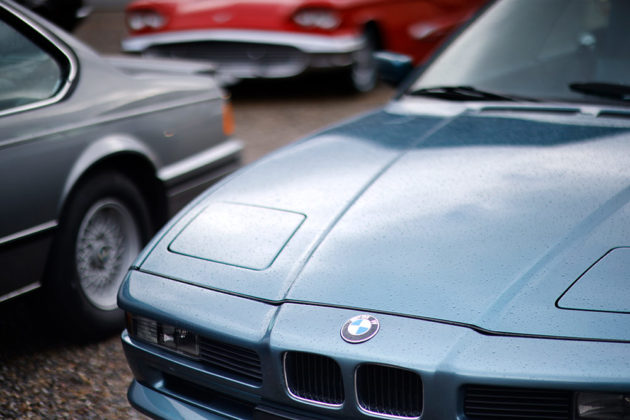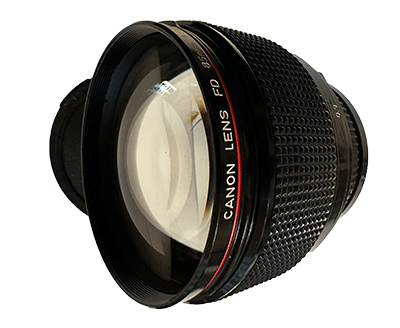Lens overview
Canon’s FD 85 mm f/1.2 L is the archetypal fast portrait prime from the last years of the manual‑focus era. It keeps the formula that made Canon’s ultra‑fast 85s famous—ground aspherical optics and a floating focusing system—but trims the body into the later new‑FD (nFD) mount, lighter and more compact than its breech‑lock predecessor. On paper, the numbers are familiar: 8 elements in 6 groups, 8‑blade diaphragm, f/1.2–16, 0.9 m MFD, 0.12× magnification, 72 mm filters, about 680 g. In practice, the draw is how it paints: faces are rendered with a gentle luminosity at f/1.2, then snap into modern crispness at f/2–2.8. If you grew up loving the FD look, this is the lens that likely put the red ring in your imagination. Canon Global
Build and ergonomics
The later nFD housing is dense but tidy (compared to the first FD), shorter than it looks in photos, and well‑balanced on mirrorless bodies with an adapter. The double‑helicoid focus unit is smooth, the aperture ring has decisive full‑stop clicks, and the BT‑72 hood remains a practical accessory outdoors. The barrel never feels fussy; it invites deliberate work. Set your focus hand at the lens, your shutter hand at the camera, and the workflow becomes second nature.
Optical performance
Sharpness & contrast. Wide open, the center is surprisingly convincing—that famous Canon “glow” is more about subject lighting than optical haze. By f/2–2.8, the micro‑contrast tightens and mid‑frame details leap forward, while edges keep improving to f/4–5.6. The floating group helps close‑range shots hold together better than most vintage f/1.2s. MIR
Bokeh & rendering. At f/1.2, the lens draws a large, round blur with soft transitions and a cinematic roll‑off. Speculars can show a touch of texture from the asphere in certain light, but it’s subtle. At portrait distances (1–2 m), the background doesn’t just recede—it dissolves. Stop at f/2, and faces keep their luminous edge while backgrounds gather a bit of structure.
Flare behavior. Direct, hard sources will lower global contrast if you’re casual with the sun; use the hood and shape your angle. Backlight becomes a creative tool rather than a liability when you flag stray rays with your hand or a card.
Chromatic aberration (and what to do about it)
Like almost every ultra‑fast 85, the FD 1.2 L shows axial chromatic aberration (LoCA) wide open: magenta/green fringing on high‑contrast edges (hairline against bright sky, jewelry, chrome, gleaming lacquer). It drops markedly from f/2–2.8, and careful exposure plus slightly warmer processing can further tame the impression.
Adobe workflow. As of today, there is no official Adobe lens profile for the Canon FD 85 mm f/1.2 L. In Lightroom/Camera Raw, enable Remove Chromatic Aberration, then use Defringe with the eyedropper on problem edges (tune Purple Amount/Hue and Green Amount/Hue). If you want geometry/vignetting correction, use Manual controls or build a custom profile (legacy Adobe Lens Profile Creator or a third‑party/user profile). Profiles do exist for the EF 85 mm f/1.2L versions; they’re not appropriate matches for the FD’s geometry, but can serve as a rough starting point for vignetting only—test before batch‑applying.
Digital adaptation
Adaptation to mirrorless is straightforward: FD→RF/Z/E/L mount adapters are thin, glassless, and retain infinity. The best experience is on bodies with IBIS (e.g., EOS R5/R6, Nikon Z, Sony A‑series): set IBIS = 85 mm and enjoy a real‑world gain in keeper rate at 1/125 s and below. If you’re on Canon EF DSLRs, achieving infinity requires optical adapters or a mount conversion; mirrorless is the path of least resistance.
Historical and collector context
This is the 1980 halo portrait lens of the FD era—successor to the FD 85 mm f/1.2 S.S.C., Aspherical, and spiritual forerunner to the EF 85 mm f/1.2L line. Collectors value clean coatings and tight mechanics; shooters value the fusion of character and capability that few peers match. It’s an L‑series that rewards both nostalgia and craft.
Impressions
The lens encourages you to slow down. Treat f/1.2–1.6 as your storytelling apertures: place the eye just inside the focus plane, let the rest be suggestion. For a more modern look, f/2–2.8 gives the same signature drawing with higher bite. At close range (0.9–1.2 m), be decisive—tiny focus shifts change the sentence the image is speaking. Indoors, bounce a soft key to keep skin accurate; outdoors, work with the hood and the sun at an angle for clean separation.
A brief modern comparison—RF 85 mm f/1.2L (and DS)
Canon’s RF 85 mm f/1.2L USM is the present‑day benchmark and, unsurprisingly, a different beast. It adds fast autofocus, BR optics to suppress axial CA aggressively, ASC coatings, and 82 mm filters in a still‑large but well‑managed barrel. The optional DS version layers Defocus Smoothing for an even softer bokeh edge. Wide open, the RF draws with greater clinical clarity and far less color fringing than any vintage 85; the FD counters with a more romantic roll‑off and a rendering that can feel hand‑wrought. If you need speed and consistency under pressure, the RF wins; if you want the crafted, manual experience with a touch more soul, the FD remains compelling.
Sample photos
Verdict — Pros & Cons
Pros
• Signature f/1.2 look with convincing center sharpness
• Aspherical + floating design holds up at near distances
• Compact for an ultra‑fast 85; 72 mm filters; rewarding manual focus
• Excellent value on mirrorless with IBIS and a basic adapter
Cons
• Axial CA wide open; needs careful light and post‑processing
• Susceptible to veiling flare from hard sources without the hood
• Manual focus only; EF DSLR use is awkward without conversion






